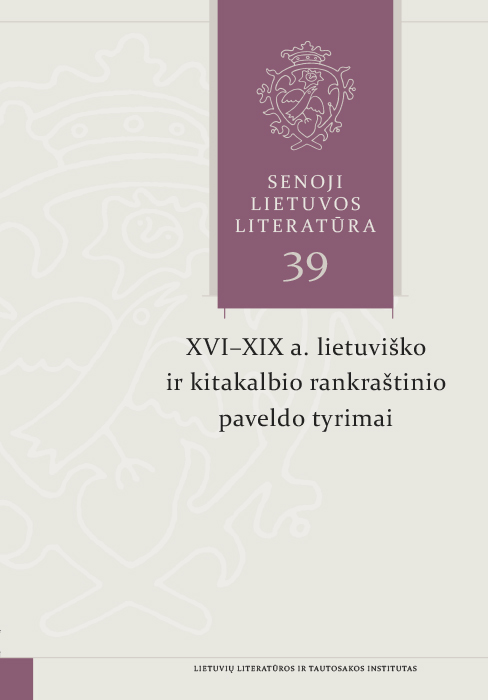The Artistic Designe of the Kražiai Jesuit Manuscript of 1695: From an Ornament to a Map
Abstract
The paper deals with the artistic design of a well-preserved manuscript that was written in 1695 during a Jesuit course of rhetoric studies in Kražiai and is kept at the Czartoryski Library in Cracow. The author gives a concise description of the ornaments of the manuscript, the peculiarities of calligraphy, the process of the emblem design, and the sequence of the teaching of rhetoric. Emphasis is laid on the exaction of the teacher Petras Puzina, his attention to the style of both the word and the text, and the language of images. A brief review is made of the literature published in Lithuania and Poland at that time and dedicated to the first beatified Jesuit, Stanislaus Kostka. The author presents the analysis of one emblematic work, TABULA GEOGRAPHICA ITINERUM / BEATI STANISLAI KOSTKA / DEVOTO ET SEQUACI CALAMO / RHETORUM S. I. REMENSA (The Map of Journeys of Blessed Stanislaus Kostka, Marked by the Devoted and Sequatious Pen of the Rhetors of the Society of Jesus, l. 409–425), which consists of the title page, a page-size illustration on the reverse of the title page, and seven emblems. The paper focuses on its visual harmony and raises the question as to what lay at the basis of the design of individual images, what textual and visual sources could be accessed, who designed the map-like illustration, and how the team work used to be carried out. The role of the teacher was of great importance in this process: he not only set tasks and compiled the syllabus, but also selected textual and visual material, specified the whole conception and its realization, encouraged innovative artistic solutions, and demanded high calligraphic and artistic quality.
Most read articles by the same author(s)
- Jolita Liškevičienė, The Noble Mikalojus Kristupas Chaleckis (Mikołaj Krzystof Chalecki) and His Literary Legacy , Senoji Lietuvos literatūra: Vol. 40 (2015): Senoji Lietuvos literatūra
- Jolita Liškevičienė, The Painting Venatio Sacra in the Chapel of Skurbutėnai: The Influence of Poetry on the Artistic Expression of a Work of Art , Senoji Lietuvos literatūra: Vol. 52 (2021): Senoji Lietuvos literatūra
